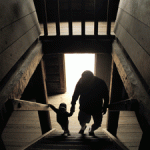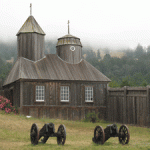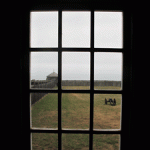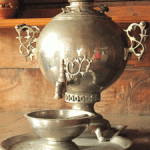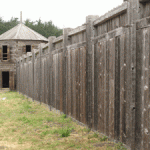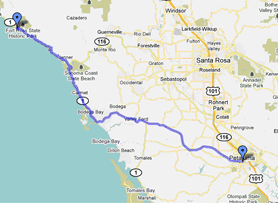Heading up Highway One, about twelve miles north of Jenner, is an off-the-beaten-track piece of California history perched on a bluff overlooking the Pacific Ocean; the Fort Ross State Historic Park. This picturesque Russian fort from the early 19th century tells the story of Russia’s brief colonial expansion into early California. With sweeping vistas and distinctive Russian architecture the fort offers a scenic as well as educational experience.
Fort Ross is the American name for what the Russians called Rossiya, named after their Russian homeland. Established in 1812 by the Russian-American Company, the fort was the southernmost Russian settlement in North America; an extension of their Alaskan fur trading endeavors. The graves originally found on San Francisco’s Russian Hill were most likely those of Fort Ross sailors and fur traders. Fort Ross was never very big, only 25 Russians and 80 Alaskans were sent to found the colony. It persevered for about thirty years before being sold to Johann Sutter of Fort Sutter in the Sacramento Valley.
Visiting Fort Ross was a something of a surprise to me. Seeing the uniquely Russian buildings sitting on the edge of North America suddenly transported me halfway around the world. The architecture was so reminiscent of old buildings that I’d seen in Siberia and being in Siberia felt so far from home. The foggy summer weather only added to otherworldliness of the place.
My family and I visited Fort Ross on a weekday so it wasn’t very crowded, making it easy to explore at our leisure. The stockade has been painstakingly restored over the years. Only one building is original, the Rotchev House built for Commander Alexander Rotchev and his wife in 1836. The remaining buildings are the Kuskov House (the original commandant’s house), the official’s barracks, a church, and two blockhouses. Many of the rooms have been staged to demonstrate their use, which adds to the atmosphere. The accommodations were austere and the exposed location must have meant some chilly winters, but certainly not too chilly for Russians that came to California from Siberia via Alaska.
Exploring the fort made kids out of all of us; peering out of the blockhouse windows at the expansive views, imagining life in another era, wondering how history might have changed if the Russian colony had been a success. With more time I would have enjoyed walking some of the trails along the coast. The location is so serene and beautiful; an inspiration to the imagination.
In spite of the park’s remote feel, Fort Ross is easy to visit. It sits just off of Highway One, about an hour and fifteen minutes from Petaluma. A small museum greets you at the entrance with a well illustrated history about the park. The stockade is an easy walk from the museum. For the more energetic visitor the park the park has various trails, day-use areas near the beach (popular with divers, surfers and tide-poolers), as well as an overnight campground. Click here for a Park Map.
For more photos visit Backyard Traveler on Facebook.
Additional Source: “Hiking and Adventure Guide to the Sonoma Coast and Russian River”, by Stephen W. Hinch, 2009.

